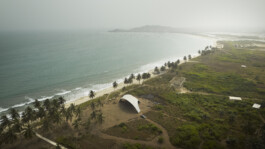

Haduwa arts and culture
Experimental architecture
Located on Ghana’s coast, the Haduwa Arts & Culture Institute is an independent place that offers artists space to work freely and involves the residents of the surrounding fishing villages. [applied] Foreign Affairs was invited to design the stage space for Haduwa’s initiatives. This project included an interdiciplinary approach were various stage situations were examined on site together with students from the School of Performing Arts at the University of Ghana, Accra. Based on this, [A]FA designed a roof and floor landscape in which each performance can be oriented differently. The building consists of a bamboo dome with three open arches facing different directions. It is large enough to accommodate diverse cultural, artistic and everyday programs. One of its spatial qualities is to offer protection against external influences such as sun, wind and rain, but at the same time to include them. The primary construction of the roof is a grid shell made entirely of bamboo. Their shape is determined by the material properties of the bamboo and its structural, technical and spatial potential.
CONCEPT AND ARCHITECTURE: [applied] Foreign Affairs, Institute for Architecture, University of Applied Arts Vienna
TIME FRAME: 2012-2014
LOCATION: Apam, Central Region, Ghana
PROJECT TEAM FOR DESIGN AND IMPLEMENTATION: Christian Car, Joseph Hofmarcher, Ilias Klis, Joana Lazarova, Ewa Lenart, Ioana Petkova, Philipp Reinsberg, with Antonella Amesberger, Andrea Sachse, Jürgen Strohmayer
PROJECT LEAD: Baerbel Mueller
BAMBOO CONSTRUCTION CONSULTING: Jörg Stamm
STRUCTURAL DESIGN: Klaus Bollinger, Clemens Preisinger, Bollinger-Grohman-Schneider
BUILDING CONSTRUCTION DETAILING: Franz Sam
ROOF MEMBRANE CONSULTING AND PLANNING: Christoph Kaltenbrunner, Manora Auersperg
PHOTOS: Julian Lanoo, Daniel Aschwanden, Baerbel Mueller